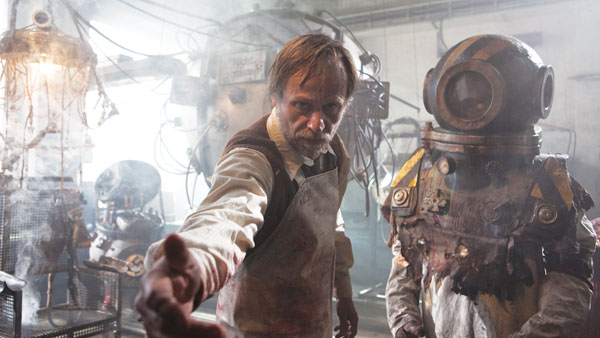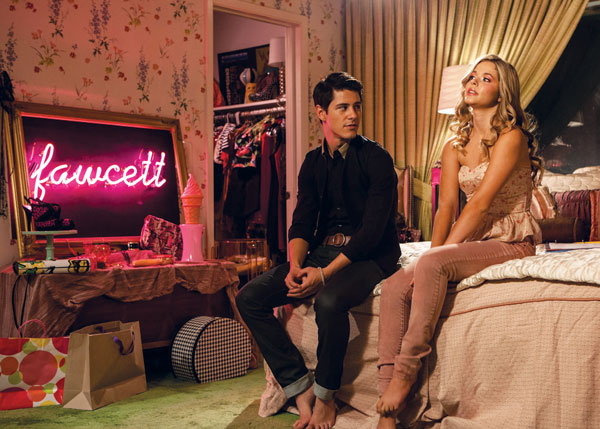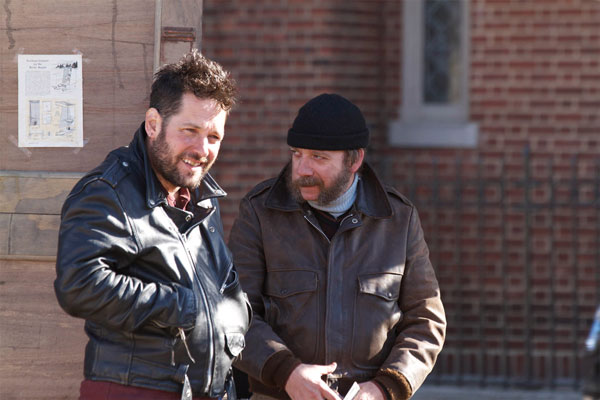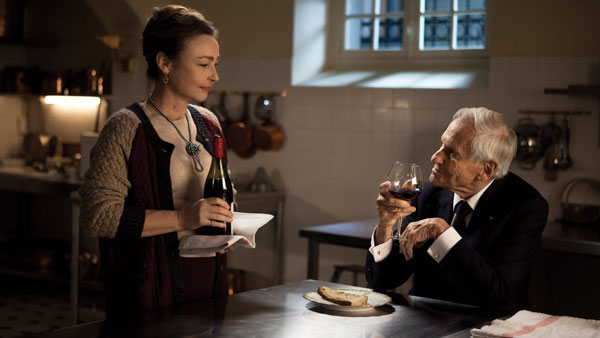
Viktor and a Machete Worker zombot pick off Russian soldiers, in “Frankenstein’s Army.”
Films that defy categorization, categorized for your convenience!
BY SCOTT STIFFLER | Like a thumbprint or a snowflake or a beautifully crafted excuse to miss work on a warm spring day, each film in this year’s festival is a unique creation. That said, even the most unconventional effort can, for marketing and viewer choice purposes, be lumped into a handful of descriptive categories. There’s a name for that, and it’s not “laziness” or “convenience.” It’s…genre.
HORROR
Nearly two decades after he cut his teeth on “Interview with the Vampire,” Neil Jordan’s “Byzantium” tells another story of two centuries-old, nomadic bloodsuckers — this time, in the form of “sisters” Eleanor and Clara, who take up residence in a small seaside town, at the titular hotel. Eleanor and Clara have about as much luck escaping their nature as a group of World War II-era Russian soldiers have of escaping a factory full of reanimated prototype supersoldiers, in “Frankenstein’s Army.” This “darkly comedic, wild steampunk, Nazi found-footage-style Zombie mad scientist film” marks the genre-splicing, blood-spattering feature film debut of Richard Raaphorst (one of the Netherlands’ top directors of commercials).
Not to be outdone in the “trapped in a spooky place” premise, “V/H/S/2” (a sequel to the 2012 outing) puts two investigators in an abandoned house, as they attempt to solve the disappearance of a student. Their decision to view a series of VHS cassette tapes containing paranormal, apocalyptic and alien invader scenarios proves very unwise (and potentially fatal). This film works its found footage premise to maximum effect by having the work of seven directors represented by the various tapes on view. In the process, it pays a massive debt to “The Blair Witch Project” (“Blair” creators Gregg Hale and Eduardo Sanchez contribute a segment that puts their own spin on gut-hungry zombie flicks).
Found footage isn’t the only horror trope on the tasty brains of the Tribeca Film Festival programmers. Those who hunger for more Frankenstein-meets-military weapon fare have another Midnight film choice, in U.K., writer/director Caradog James’ “The Machine.” Set during a second Cold War, Britain’s Ministry of Defense sees potential in the work of programmer Vincent McCarthy — whose human cyborg prototype avoids the draft by decimating his lab and generally going bonkers. Things go downhill from there, when McCarthy continues his obsessive work (underground and off the books).
LGBT
The robust list of lesbian, gay, bisexual and transgender-themed films starts off with a bang — or, more accurately, a pair of B’s: “BIG JOY: The Adventures of James Broughton,” is a documentary (or, as its creators describe it, a “celebratory portrait”) of the post-World War II, San Francisco-based poet and filmmaker. Home movies, historic photographs and interviews with contemporary admirers (as well as quotations from Broughton’s writings and clips from his movies) are used to put all of his artistic endeavors into context, with special concentration on his creative writing and filmmaking.
Linda Bloodworth-Thomason (who long ago secured her gay cult appeal cred by creating “Designing Women”) brings the world premiere of her documentary to the festival. “Bridegroom” looks at the ongoing debate over the legal rights of same-sex couples by zeroing in on one of them — Shane and Tom (who, six years into their relationship, experience a tragic accident that leaves one of them fighting “to be recognized as his soulmate’s legitimate counterpart”).

Tanner (Michael J. Willett) has a bonding moment with Fawcett (Sasha Pieterse), in “G.B.F.”
Fifteen years after “Heathers” and nine years after “Mean Girls,” clique culture remains every bit as cutthroat as it was when Winona Ryder and Lindsay Lohan roamed the high school hallways (and they turned out just fine, didn’t they?). “G.B.F.” has three popular girls fighting for supremacy by becoming the first Gay Best Friend of Tanner, their school’s first openly gay student.
Close friendship has darker, more erotic consequences in “Floating Skyscrapers.” Polish writer and director Tomasz Wasilewski’s second feature takes off when Kuba (at an art opening with his girlfriend of two years) bumps into Mikal. Sparks fly, and Kuba soon finds himself losing interest in girls…and sports! Soon, he’s spending less time in the swimming pool, and more time “drowning in the destruction of his desires.”
NEW YORK STORIES
Well aware that we’re living in the world’s biggest, best, open-air backlot, the festival has always had a soft spot for films set amongst the streets, bridges and iconic landmarks of the five boroughs.

Rene (Paul Rudd) and Dennis (Paul Giamatti) try to make a quick buck selling trees, in “Almost Christmas.”
In “Almost Christmas,” two iconic Pauls play French Canadian ne’er-do-wells determined to make a quick fortune selling Christmas trees in NYC. Sally Hawkins co-stars as the wife of misanthropic ex-con Dennis (Paul Giamatti). She’s being romanced by the charming Rene (Paul Rudd). Phil Morrison (“Junebug”), equally adept at quirky charm and genuine emotion (often in the same scene), directs.
She recently announced her intentions to leave our city — so it’s a good thing documentary filmmaker Chiemi Karasawa’s “Elaine Stritch: Shoot Me” captured the then-87-year-old Broadway legend in all her Gotham glory. Testimonials from the likes of Tina Fey and Hal Prince, as well as brutally honest insights from the lady herself, promise to “reach beyond Stritch’s brassy exterior, revealing a multi-dimensional portrait of a complex woman.” If the film manages to deliver, its 80 minutes will be worth more than a month’s worth of James Lipton interviews.
Based on a true story, “Stand Clear of the Closing Doors” is set in Far Rockaway, in the days leading up to Hurricane Sandy. Its parallel story follows two people making connections and finding community — as the mother of autistic teen Ricky combs the streets, while her son rides the subway.
Four short films also make good use of the city. In “Ice,” unlucky-in-love enforcer Ronnie (between jobs for his Brooklyn crime boss) hides out in the backroom of a bar, sculpting ice and exploring the roots of his ambivalence. Five minutes is all it takes to tell the story of “Two Islands” — a pair of enormous waste dumps that put the city’s rejected surplus into perspective. In “Zzzzzz,” sleepwalkers Henry and Lucy take the audience along on a tour of nocturnal sights and sounds. Saved from the trash heap and taken to a repair shop in the Flatiron building, a seemingly obsolescent “Royal American” typewriter is used to write letters (answered by, among others, President Clinton).
FOREIGN FILMS
If past years are any indication (and they almost always are), foreign language films will account for the festival’s strongest entries in virtually every category — acting, cinematography, art direction and, of course, subtitles. The 2013 roster includes entries from Australia (“Red Obsession”), Belgium (“Broken Circle Breakdown”), Brazil (“Reaching for the Moon,” Canada (“Whitewash ), Denmark (“Northwest”), India (the documentary “Powerless,” favorably reviewed by our Sam Spokony), Iran (“Taboor”), Israel (“Big Bad Wolves”), Italy (“Ali Blue Eyes”), Japan (“Odayaka”), New Zealand (“Fresh Meat”), Saudi Arabia/Germany (“Wajdja”) and Turkey (“Jin”).

A cook plucked from obscurity is called upon to serve her country’s president, in “Haute Cuisine.”
A trusted friend’s recent, unexpectedly persuasive case as to why the French hold Jerry Lewis films in such high regard inspired my curiosity about two efforts from that heretofore impenetrable country. In “Cycling with Moliere,” once-great actor Serge Tanneur finds himself twisting in the wind, cycling through France’s Île de Ré — when an old friend temps him to return to the stage, in Molière’s “The Misanthrope.” A chef toiling in obscurity is chosen to whip up classic French dishes for her nation’s president, in “Haute Cuisine.” It’s based on the real-life story of the personal chef to former French president François Mitterrand.

















